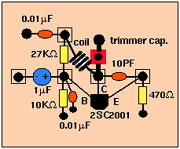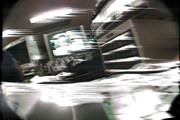 You are familiar with the most simplest FM transmitter" that I designed (left).
Let's try to transform it into a TV transmitter. Just change the input from the audio to the video (video camera or VCR) and check the signal at your television set: in Europe, for instance, choose the channel 2 - 4 and turn the trimmercap ot the transmitter. You will find some images or might watch a clear image. This suggests that it will be not so difficult to build a TV transmitter.
You are familiar with the most simplest FM transmitter" that I designed (left).
Let's try to transform it into a TV transmitter. Just change the input from the audio to the video (video camera or VCR) and check the signal at your television set: in Europe, for instance, choose the channel 2 - 4 and turn the trimmercap ot the transmitter. You will find some images or might watch a clear image. This suggests that it will be not so difficult to build a TV transmitter.↓
 The practically improved schematic is here but you need a bit more soohistication.
The practically improved schematic is here but you need a bit more soohistication.↓
 This should be a practical model of the simplest TV transmitter. You can delicately adjust the conditions to your TV receiver.
This should be a practical model of the simplest TV transmitter. You can delicately adjust the conditions to your TV receiver.A Simple model that will make you worth trying.(PDF)
Cautions:
In case I would like to emphasize that in some area this "simplest" TV transmitter may not work well. Because in some countries, radio and television use very different frequencies. This experimental conversion supposes that you can have TV channels of the frequencies between 76 and 108 MHz, that are the same with the FM radio frequencies in the world.
Also, you have to know that this transmitter cannot be fit for today's "sophisticated" auto-tuning and noise-cutting TV receiver . It recogn izes the transmitting signals of this modest transmitter as "irrelevant" noises. This is the irony of the "advanced" technology!
Look for a TV set that was sold before the 1990s.
The first step:
You have to find a vacant channel first and foremost. There are source books in the net such as this. And select the similar frequency as the FM radio (76-90-108MHz).
This is important for making the coil: how many turns you need depends on the frequency you will use.
The lower frequency will enable you to easily build the transmitter because the higher frequency demands you a bit higher skills.
How to build?:
Please see the explanations in the pages of the simplest FM transmitter.
How to operate the transmitter?
(1)Prepare television set(s). It would be better to have two or more sets for adjusting the transmitting frequency. There might several harmonic frequencies of the transmitter and they may confuse you. If you have a frequency counter, it would be perfect.
Connect an "indoor TV antenna" to your televison. There are various types of "indoor TV antennas. If you use two TV sets, you need the two antennas. As for the antenna of the transmitter, please check the manual. The distance between the transmitter and the TV set(s) must be close.
(2)Turn on and select a vacant channel of VHF (30 - 300 MHz). There are different plans in countries and areas. Every plan has a set of frequencies of video and sounds. We are now interested in the frequency of the video only. For instance, Japan has 1-12 channels and the vacant video frequencies are 97.25 MHz(2ch), 177.25 MHz(5ch), 189.25 MHz(7ch), 199.25 MHz(9ch), and 211.25 MHz(11ch). Most of the countries have lower frequency. For instance, U.S. has 2-13 channels (55.25-2ch., 61.25-3ch., 67.25 MHz-4ch., 77.25 MHz-5ch., 83.25 MHz-6ch., 175.25 MHz-7ch., 181.25 MHz-8ch., 187.25 MHz-9ch., 193.25 MHz-11ch., 204.25 MHz-12ch., and 211.25 MHz-13ch.), Italy: channel A-H2 (53.75 MHz - 224.25 MHz), France: ch. A(47.75 MHz) to 6 (216.00 MHz), New Zealand: ch.1(45.25 MHz) to ch.9(210.25 MHz), Australia: ch.0 (46.25 MHz) to ch.11(216.25 MHz), Russia: ch1 (49.75 MHz) to ch.12 (223.25 MHz).
(3)Connect the composite signals of your VCR, DVD player, camcorder and so on to the video input of "The most simplest TV Transmitter". There is no problem of the different video formats such as NTSC, PAL, SECAM if you use the same format of video source and television set. Supply the power.
Then turn the two trimmer capacitors one after the other very slowly. You will find a sudden change of the screen and will have a distorted or clear image of your video source. Two television sets would be more convenient to adjust the exact frequency for your vacant channel you selected. Turn the capacitor until the all sets get the clearest images together. But in this stage, the images may be distorted.

Turn the variable register of the video input of the transmitter and adjust the proper input. You will get the normal images. These processes need some of skills and the operations would be delicate. Please be patient.
When you succeed in this version to work, you may try the advanced version. In this version, stability and quality are improved. This can have even the audio too. However, in order to complete this, you have to use a proper frequency counter.
home of Polymorphous Space How to build a transmitter top of micro silent TV Contact to Tetsuo Kogawa (mail: polym@translocal.jp)
